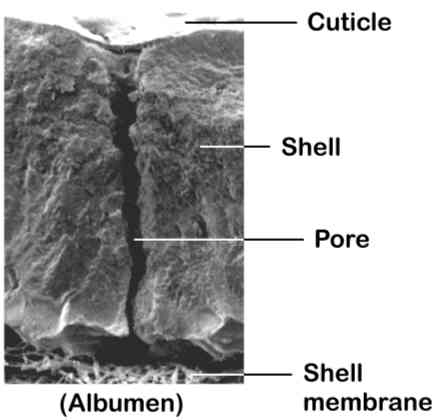



Contamination of hatching eggs
Prepared by Michael Wineland, Extension Poultry Specialist and Carmen Christopher, North Carolina State University - This article looks at where the microbial contamination come from in hatching eggs and discusses what management strategies can be practiced to reduce egg contamination.Where does microbial contamination come from?
Bacteria and mold which can affect hatching eggs are found everywhere in the environment--in soil, in manure, and even on the dust particles in the air. The most common way hatching eggs become contaminated is by allowing fresh eggs to lay in dirty nests or on the floor and slats.
How does microbial contamination affect the eggs and chicks?
When a large number of bacteria get onto the shell surface, the chances of bacteria invading the egg increase. Bacteria inside the egg may use the nutrients found in the egg to multiply, robbing the embryo of a crucial food source or perhaps producing a toxin harmful to the embryo. During incubation, bacteria can actually prevent embryonic development, ultimately causing the embryo to die. Even if the embryo of a contaminated egg survives hatching, the chick will either die in the broiler house or simply not grow as it should.
Contaminated eggs that fail to hatch in the incubator can also affect other, healthy eggs. If one contaminated egg should crack in the incubator, it may spread bacteria to other eggs or newly hatched chicks. In fact, one egg can affect an entire incubator.
Does the egg possess any anti-microbial defenses?
Although bacteria and mold can easily find a path into a cracked egg, the intact egg possesses many defenses that prevent microbial infection. Barriers that protect the egg include the cuticle, the shell, the shell membrane and the albumen or egg white (See Figure 1).
| Figure 1. Microscopic Cross-Section of an Egg Shell (Lucore, 1994) | ||
 |
||
A protein layer located on the shell surface is called the "cuticle." The cuticle helps occlude-or cover over-some of the pore openings to minimize bacterial penetration. Sometimes, though, if the cuticle layer is thin, the pores are too large or the shell too thin, bacteria can enter through the pore of the shell. If this should happen, the shell has two membranes lining the inside of it which act like a filter to prevent penetration. Additionally, the albumen contains natural compounds which can kill any bacteria that may evade the egg's other protective features.
However protected the egg may seem, if the number of bacteria is too great, the natural defenses cannot prevent invasion. Good management practices are essential to minimize the assault of bacteria upon freshly laid hatching eggs.
What management strategies can be practiced to reduce egg contamination?
Collect eggs frequently to minimize the time that they are exposed to a contaminated environment. Keep egg laying areas as clean as possible, including the nest litter or pads. Remove eggs to the egg cooler as soon as possible after lay; cooler temperatures will slow the growth of bacteria on the shell surface. Prevent moisture from accumulating on the shell. Moisture provides a needed nutrient for microbial growth and might also provide a medium to aid the movement of microbes through the shell. Use authorized egg shell sanitation or fumigation programs properly. Minimize the number of cracked or broken eggs. Egg contents can provide nutrients for the bacteria to multiply and spread. Avoid abrasive cleaning of the egg which can affect the integrity of the shell. Increase efforts to minimize contamination as the breeder flock's age increases. The shell becomes thinner with age and more prone to bacterial infection.
Works Cited
Lucore, L. M.S. Thesis, 1994. NC State University.
Source: North Carolina State University Cooperative Extension Service - October 2003








